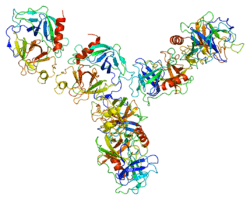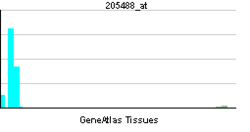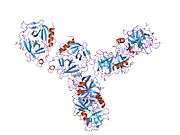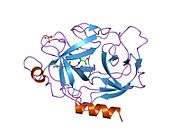GZMA
| GZMA | |||||||||||||||
|---|---|---|---|---|---|---|---|---|---|---|---|---|---|---|---|
 |
|||||||||||||||
| |||||||||||||||
| Identifiers | |||||||||||||||
| Aliases | GZMA, CTLA3, HFSP, granzyme A | ||||||||||||||
| External IDs | MGI: 109266 HomoloGene: 21237 GeneCards: GZMA | ||||||||||||||
| RNA expression pattern | |||||||||||||||
 | |||||||||||||||
| More reference expression data | |||||||||||||||
| Orthologs | |||||||||||||||
| Species | Human | Mouse | |||||||||||||
| Entrez | |||||||||||||||
| Ensembl | |||||||||||||||
| UniProt | |||||||||||||||
| RefSeq (mRNA) | |||||||||||||||
| RefSeq (protein) | |||||||||||||||
| Location (UCSC) | Chr 5: 55.1 – 55.11 Mb | Chr 13: 113.09 – 113.1 Mb | |||||||||||||
| PubMed search | [1] | [2] | |||||||||||||
| Wikidata | |||||||||||||||
| View/Edit Human | View/Edit Mouse |
Granzyme A is a protein that in humans is encoded by the GZMA gene, and is one of the five granzymes encoded in the human genome .[3][4][5]
Cytolytic T lymphocytes (CTL) and natural killer (NK) cells share the remarkable ability to recognize, bind, and lyse specific target cells. They are thought to protect their host by lysing cells bearing on their surface 'nonself' antigens, usually peptides or proteins resulting from infection by intracellular pathogens. The protein described here is a T cell- and natural killer cell-specific serine protease that may function as a common component necessary for lysis of target cells by cytotoxic T lymphocytes and natural killer cells.[5]
Human Granzyme Genes
References
- ↑ "Human PubMed Reference:".
- ↑ "Mouse PubMed Reference:".
- ↑ Hameed A, Lowrey DM, Lichtenheld M, Podack ER (Nov 1988). "Characterization of three serine esterases isolated from human IL-2 activated killer cells". J Immunol. 141 (9): 3142–7. PMID 3262682.
- ↑ Masson D, Zamai M, Tschopp J (Dec 1986). "Identification of granzyme A isolated from cytotoxic T-lymphocyte-granules as one of the proteases encoded by CTL-specific genes". FEBS Lett. 208 (1): 84–8. doi:10.1016/0014-5793(86)81537-X. PMID 3533635.
- 1 2 "Entrez Gene: GZMA granzyme A (granzyme 1, cytotoxic T-lymphocyte-associated serine esterase 3)".
Further reading
- Pasternack MS, Bleier KJ, McInerney TN (1991). "Granzyme A binding to target cell proteins. Granzyme A binds to and cleaves nucleolin in vitro". J. Biol. Chem. 266 (22): 14703–8. PMID 1860869.
- Poe M, Bennett CD, Biddison WE, et al. (1988). "Human cytotoxic lymphocyte tryptase. Its purification from granules and the characterization of inhibitor and substrate specificity". J. Biol. Chem. 263 (26): 13215–22. PMID 3047119.
- Murphy ME, Moult J, Bleackley RC, et al. (1989). "Comparative molecular model building of two serine proteinases from cytotoxic T lymphocytes". Proteins. 4 (3): 190–204. doi:10.1002/prot.340040306. PMID 3237717.
- Gershenfeld HK, Hershberger RJ, Shows TB, Weissman IL (1988). "Cloning and chromosomal assignment of a human cDNA encoding a T cell- and natural killer cell-specific trypsin-like serine protease". Proc. Natl. Acad. Sci. U.S.A. 85 (4): 1184–8. doi:10.1073/pnas.85.4.1184. PMC 279731
 . PMID 3257574.
. PMID 3257574. - Krähenbühl O, Rey C, Jenne D, et al. (1988). "Characterization of granzymes A and B isolated from granules of cloned human cytotoxic T lymphocytes". J. Immunol. 141 (10): 3471–7. PMID 3263427.
- Baetz K, Isaaz S, Griffiths GM (1995). "Loss of cytotoxic T lymphocyte function in Chediak-Higashi syndrome arises from a secretory defect that prevents lytic granule exocytosis". J. Immunol. 154 (11): 6122–31. PMID 7751653.
- Inoue M, Hoshino T, Fukuma T, et al. (1994). "Close co-localization of CD4 and a serine esterase tryptase TL2 on the cell-surface of human monocytoid and CD4+ lymphoid cells". Biochem. Biophys. Res. Commun. 201 (3): 1390–5. doi:10.1006/bbrc.1994.1857. PMID 7912927.
- Fink TM, Lichter P, Wekerle H, et al. (1994). "The human granzyme A (HFSP, CTLA3) gene maps to 5q11-q12 and defines a new locus of the serine protease superfamily". Genomics. 18 (2): 401–3. doi:10.1006/geno.1993.1483. PMID 8288245.
- Beresford PJ, Kam CM, Powers JC, Lieberman J (1997). "Recombinant human granzyme A binds to two putative HLA-associated proteins and cleaves one of them". Proc. Natl. Acad. Sci. U.S.A. 94 (17): 9285–90. doi:10.1073/pnas.94.17.9285. PMC 23158
 . PMID 9256474.
. PMID 9256474. - Spaeny-Dekking EH, Hanna WL, Wolbink AM, et al. (1998). "Extracellular granzymes A and B in humans: detection of native species during CTL responses in vitro and in vivo". J. Immunol. 160 (7): 3610–6. PMID 9531325.
- Zhang D, Beresford PJ, Greenberg AH, Lieberman J (2001). "Granzymes A and B directly cleave lamins and disrupt the nuclear lamina during granule-mediated cytolysis". Proc. Natl. Acad. Sci. U.S.A. 98 (10): 5746–51. doi:10.1073/pnas.101329598. PMC 33284
 . PMID 11331782.
. PMID 11331782. - Beresford PJ, Zhang D, Oh DY, et al. (2001). "Granzyme A activates an endoplasmic reticulum-associated caspase-independent nuclease to induce single-stranded DNA nicks". J. Biol. Chem. 276 (46): 43285–93. doi:10.1074/jbc.M108137200. PMID 11555662.
- Fan Z, Beresford PJ, Zhang D, Lieberman J (2002). "HMG2 Interacts with the Nucleosome Assembly Protein SET and Is a Target of the Cytotoxic T-Lymphocyte Protease Granzyme A". Mol. Cell. Biol. 22 (8): 2810–20. doi:10.1128/MCB.22.8.2810-2820.2002. PMC 133744
 . PMID 11909973.
. PMID 11909973. - Strausberg RL, Feingold EA, Grouse LH, et al. (2003). "Generation and initial analysis of more than 15,000 full-length human and mouse cDNA sequences". Proc. Natl. Acad. Sci. U.S.A. 99 (26): 16899–903. doi:10.1073/pnas.242603899. PMC 139241
 . PMID 12477932.
. PMID 12477932. - Fan Z, Beresford PJ, Zhang D, et al. (2003). "Cleaving the oxidative repair protein Ape1 enhances cell death mediated by granzyme A". Nat. Immunol. 4 (2): 145–53. doi:10.1038/ni885. PMID 12524539.
- Pinkoski MJ, Green DR (2003). "Granzyme A: the road less traveled". Nat. Immunol. 4 (2): 106–8. doi:10.1038/ni0203-106. PMID 12555094.
- Saito S, Iida A, Sekine A, et al. (2003). "Catalog of 680 variations among eight cytochrome p450 ( CYP) genes, nine esterase genes, and two other genes in the Japanese population". J. Hum. Genet. 48 (5): 249–70. doi:10.1007/s10038-003-0021-7. PMID 12721789.
- Bell JK, Goetz DH, Mahrus S, et al. (2003). "The oligomeric structure of human granzyme A is a determinant of its extended substrate specificity". Nat. Struct. Biol. 10 (7): 527–34. doi:10.1038/nsb944. PMID 12819769.
This article is issued from Wikipedia - version of the 11/26/2016. The text is available under the Creative Commons Attribution/Share Alike but additional terms may apply for the media files.

